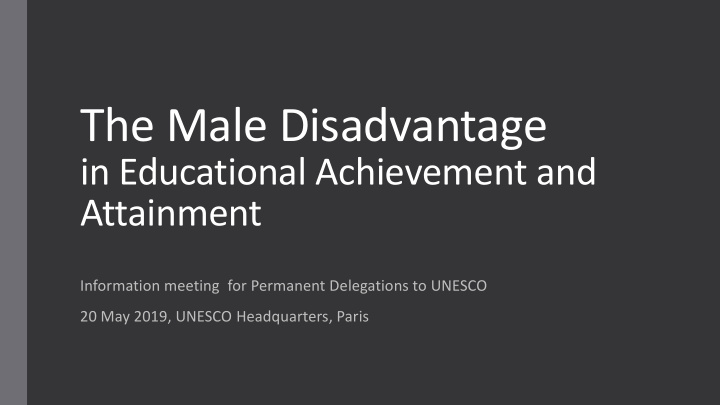



The Male Disadvantage in Educational Achievement and Attainment Information meeting for Permanent Delegations to UNESCO 20 May 2019, UNESCO Headquarters, Paris
Sustainable Development Goals (SDGs) Ensure inclusive and equitable quality education and promote lifelong learning opportunities for all
Education for All (EFA) Goals Eliminating gender disparities in primary and secondary education by 2005, and achieving gender equality in education by 2015, with a focus on ensuring girls’ full and equal access to and achievement in basic education of good quality .
National Commission on Gender Equality in Education Report submitted in February 2019. An English translation of the report is forthcoming: https://nettsteder.regjeringen.no/stoltenbergutvalget/
Commission Mandate All pupils have equal right to quality learning in school EVIDENCE Building evidence on causes of the gender gap in education POLICY and interventions Offer local and national authorities knowledge to inform their choices of efficient policies and interventions to prevent unfavourable gender gaps in educational achievement
Gender gaps in the education system and lifecourse outcomes
Long term trends in the gender gap in tertiary attainment % point dif. OECD average Netherlands Switzerland United States Norway 15 Gender gap (female - male) 10 5 0 -5 -10 -15 Cohort birth period Source: Barro and Lee, 2013. OECD report Figure 2.1.
The gender gap in high income/emerging countries Percentage of women among recently graduated bachelor students, 2015 80 70 60 50 40 30 20 10 0 Source: OECD Education Database, 2018
Proportions of women and men in Norway with higher education. Age 30-39. 1970-2016 Men Women Statistics Norway 2018
Life expectancy at different levels of educational attainment at age 30, by gender, 2009-2015, in Norway 90 88 86 84 82 80 78 76 74 72 70 Men Women Men Women Men Women Primary and Lower Secondary Education Upper Secondary Education Tertiary Education Source: Norwegian Institute of Public Health (2016)
Proportion of men and women without children at age 45 in Norway Source: Statistics Norway 2018
Girls do better in all subjects in school except physical education in Norway Gender gap final marks Gender gap examination marks 0,8 0,7 0,6 Gender gap (girsl-boys) 0,5 0,4 0,3 0,2 0,1 0 -0,1 -0,2 -0,3 Gender gaps in final marks and examination marks in 10th grade (examination form in parentheses), 2017. Source: Statistics Norway, StatBank
In Norway, girls do better than boys across the whole GPA distribution Number of students Average school points Boys Girls GPA distribution in 10th grade (lower secondary education) by gender, 2018. Source: Requested from the Norwegian Directorate for Education and Training, 2018
The gender gap is easiest to spot in the upper and lower parts of the GPA distribution Number of students Average school points Boys Girls GPA distribution in 10th grade (lower secondary education) by gender, 2018. Source: Requested from the Norwegian Directorate for Education and Training, 2018
In Norway, the gender gap in GPA score persists across parents' educational levels 60,0 Boys Girls 4,3 4,5 50,0 4,0 4,6 Average school points 40,0 30,0 20,0 10,0 0,0 Mandatory Upper secondary Tertiary education, Tertiary education, education or no education 4 years or less more than 4 years Parents' education level education GPA score by gender and parents' education level, 2018. Source: Statistics Norway, StatBank
Causal factors contributing to the gender gap in education
Not one, but two questions: 1. Why do we see a reversal of the gender gap in educational attainment in favour of women since the 1970s? 2. Why is there a gender gap in educational achievement in disfavour of boys, dating back as long as we have data?
1) Why gender gap in educational attainment PERHAPS: • Equal opportunities • Career expectations • Local labour market • Economic returns to education • Signaling value of higher education
2) Why gender gap in educational achievement Teacher-pupil-interaction Teacher gender – NO Teacher evaluated tests – PERHAPS, but only explains a small fraction of the gender gap
Male share of new entrants in tertiary education is lower in countries where teacher assessments are more common Share of males among new entrants in tertiary 54 52 SWE LTU ESP 50 FIN ISR R² = 0,3247 education CHL 48 BEL POL TUR JPN LUX ITA SVK DNK RUS MEX ARG 46 NZL NLD ISL 44 CHE NOR DEU CZE AUT SVN PRT 42 COL HUN 40 20 30 40 50 60 70 80 90 100 Sources: Adapted from OECD, PISA 2015 database and (OECD, 2017) “Education at a Glance”.
2) Why gender gap in educational achievement, cont. Gender differences in development Self-regulation and social skills Cognitive development in puberty Cognitive profile and language development
At age 15, girls perform better in reading than boys in all countries depicted Girls Boys 0,5 0,3 0,1 -0,1 -0,3 -0,5 -0,7 -0,9 Source: OECD, PISA (2015)
Reading skills of boys and girls improve – gender gap persists Girls Boys Reading skills in 4th grade by gender, PIRLS. Source: Borgonovi (2018)
Recommendations by the Commission
Guiding principles The policy measures shall • Improve boys' performance, not impair girls' performance • Help reducing the socio-economic gap in performance • Target both boys and girls, men and women • Contribute to an inclusive learning environment • Be evidence-based
Four main areas of education policy 1) Early intervention and adapted education e.g. flexible school starting age 2) Content and structure in primary and lower secondary education e.g. different weighting of final and examination marks 3) Transitions in the educational pathway e.g. the right to apprenticeships for pupils in TVET programs 4) Evidence system for kindergarten, primary and secondary education e.g. develop a national course database for education
Conclusions • The gender gap is a social grand challenge requiring policies and interventions • The evidence is too weak to conclude on the causes of the gender gap • There are almost no country examples of policies and interventions that are efficient to prevent or mitigate the gender gap - this calls for cooperation between countries • Achieving gender equality in education for both genders is possible
Thank you
Recommend
More recommend